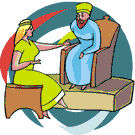Purim
Purim is the most festive of all the Jewish holidays. It occurs on the 14th and 15th days of Adar, the 12th month of the Jewish calendar. On the Western Calendar for 2025, this is March 14. The story of Purim is a happy one, the story of a great victory over near certain doom. Its hero is a woman: Esther. The Ancient Israelites underwent many tests during their long history. One of the most severe came at the hands of Achashverosh, the king of Persia, and his most trusted adviser, a man named Haman. Mordecai was an important Jewish man living in Persia. He had reared his cousin Esther as if she were his own daughter. When she was of a certain age, she was commanded to go live with the king. King Achashverosh loved Esther more than any other woman in his kingdom and so made her queen. The king did not know, however, that Esther was Jewish. At this time, Haman wanted to destroy the Jews. He especially did not like Mordecai, Esther's cousin. Mordecai refused to bow down to Haman and told other Jews to similarly ignore the king's adviser. Enraged, Haman went to the king and asked for permission to kill Mordecai. He and the other Jews did not obey the king's laws, Haman argued, preferring to put their god's (Yahweh's) laws first. Surely this was treason and punishable by death, Haman argued. The king agreed and decreed that Mordecai should die, as an example; then, Haman planned, the rest of the Jews would die as well. Hearing this, Esther decided that she must do something. Even though she was the queen and the king's most beloved, she still had relatively little power. At that time, a woman could not even talk to the king unless he had invited her to do so.
Today, Jews celebrate Purim with loud noises and happy feasting. This feasting is made all the more special because of the fasting that goes on the day before, in honor of the fasting that Esther undertook to seek guidance from above. One of the main foods eaten is Hamentaschen, a special type of bread that takes its name in part from the villain Haman.
They also give gifts to one another and to the poor. Unlike other holidays, however, Jews are not encouraged to stay home from work on Purim. The name Purim itself means "lots" and comes from Haman's "lottery," the drawing of lots to see on which day the massacre of the Jews would come. That day, of course, is the day on which Purim is now celebrated. It is sometimes called the "Festival of Lots." |
|
Social Studies for Kids
copyright 2002–2024
David White



 Esther knew that she must act, but what could she do? She fasted for three days and prayed, seeking guidance. In the meantime, Haman directed his man to build a gallows, on which to hang Mordecai. Desperate, Esther went to talk to King Achashverosh. She urged him not to have her people killed. She told him of Haman's plot and of the all the terrible things that he had already done to her people. She revealed to him that she was, in fact, a Jew. The king could have had her killed for coming to him uninvited; instead, he agreed with her. In a stunning turnabout, the king ordered Mordecai and Haman put to death in his place, on the very same gallows that the adviser had ordered built.
Esther knew that she must act, but what could she do? She fasted for three days and prayed, seeking guidance. In the meantime, Haman directed his man to build a gallows, on which to hang Mordecai. Desperate, Esther went to talk to King Achashverosh. She urged him not to have her people killed. She told him of Haman's plot and of the all the terrible things that he had already done to her people. She revealed to him that she was, in fact, a Jew. The king could have had her killed for coming to him uninvited; instead, he agreed with her. In a stunning turnabout, the king ordered Mordecai and Haman put to death in his place, on the very same gallows that the adviser had ordered built. Also on Purim, Jews celebrate by hearing read the Megilla, the story of Esther and her courage. They rattle special noisemakers called gragers whenever Haman's name is mentioned.
Also on Purim, Jews celebrate by hearing read the Megilla, the story of Esther and her courage. They rattle special noisemakers called gragers whenever Haman's name is mentioned.
